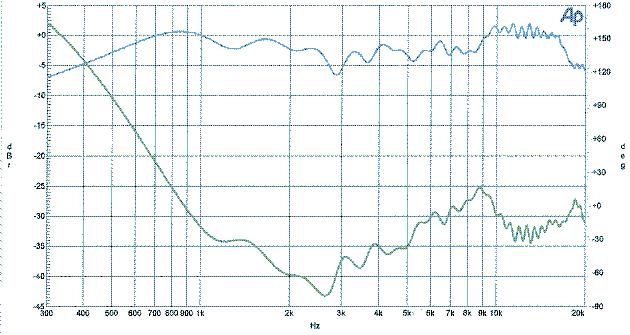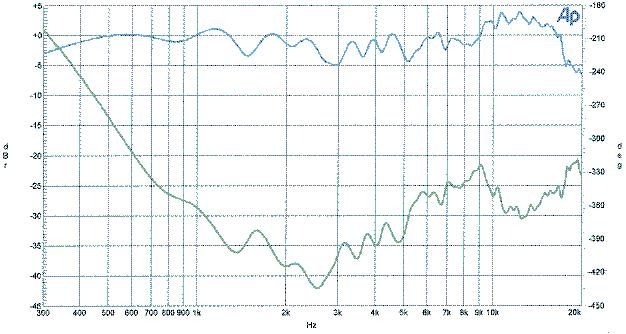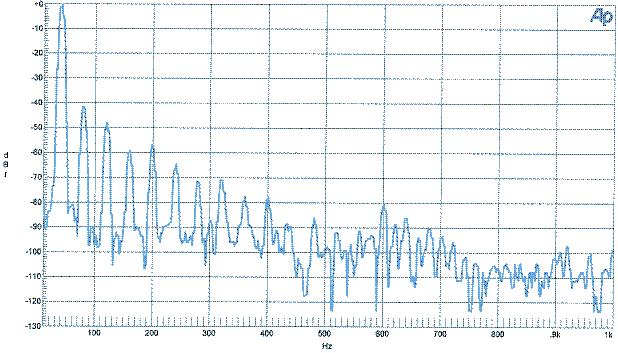Powered 4-Way Digital Loudspeaker System Bang & Olufsen BeoLab 5
- 04 Feb 2005 13:10
- 1130

Bang & Olufsen America, Inc., 780 West Dundee Road, Arlington Heights, IL 60004. Voice: (847) 590-4900. Fax: (847) 255-9064. E-mail: beoinfo1@bang-olufsen.dk. Web: www.bang-olufsen.com. BeoLab 5 loudspeaker system, $16,000.00 the pair. Tested samples on loan from manufacturer.
I have a dream. I dream of the Ultimate Loudspeaker. It can only exist in my dream because in the real world no manufacturer would have the overarching vision and multifaceted expertise to incorporate each and every one of its ideal features in a single design. No way; it could never happen. It would of course have to be a powered loudspeaker because perfect matching of the amplifier channels to the drivers is possible that way and because separate, free-standing power amplifiers are hopelessly twentieth-century. It would have to be a 4-way loudspeaker because 3-way design always stretches the capabilities of the drivers to the limit. It would have high-order digital filters in the electronic crossover because they are linear-phase and just plain superior. The four power amplifiers would be extremely powerful yet small enough to be tucked unobtrusively inside the speaker enclosure, thanks to the most sophisticated switch-mode design. The various functions and protection modes of the speaker would be controlled by a powerful internal computer and DSP processor, which would also permit a single digital S/PDIF connection from a stereo signal source to produce music from the all-in-one amplifier/speaker system. One of the capabilities of the DSP would be to tune the bass response of the speaker to its specific location in the listening room. (I can dream, can’t I?) Also, the midrange and treble response of the speaker would be much wider in dispersion than the usual 60° or 90°, extending essentially to 180°, so that the location of the listener would become totally unimportant. (Asking for the moon? What are dreams for?)
Am I still dreaming? What are those two strange-looking monoliths in my listening room? Could they be loudspeakers? Introducing the Bang & Olufsen BeoLab 5, the speaker that makes my dream come true in every detail, bar none. I can hardly believe it. Amazing. Speakers will never be the same again.
The Design
Bang & Olufsen really did it this time. The Danish firm whose philosophy always seemed to be cosmetics (“Dansk design”) first, engineering second, has leapfrogged the whole speaker industry with an engineering design so advanced and so imaginative that it leaves everyone else in the dust. The BeoLab 5 is the most sophisticated piece of loudspeaker engineering in the world today, at least in the world known to me—and they didn’t neglect the cosmetics, either. Just look at it! It’s a tour de force both technically and visually. There is simply nothing else like it. For once, the high price tag (sixteen big ones) does not appear to be excessive when you “look under the hood.”
The drivers around which the BeoLab 5 is designed are a 15" subwoofer, a 6½" upper woofer, a 3" soft-dome midrange unit, and a ¾" soft-dome tweeter. The downward-facing subwoofer is in a 29-liter (just over 1 cubic foot) sealed enclosure, remarkably small for the high-level 18-Hz capability, and proof of both the elaborate electronic equalization and the large excursion range of the driver. The upper woofer is in a 5-liter (0.18 cubic foot) sealed enclosure, facing forward. The midrange driver and tweeter each face upward and fire into very special acoustic lenses, one larger and one smaller, licensed from Sausalito Audio Works. This Acoustic Lens Technology, invented by SAW president Manny LaCarrubba, permits 180° dispersion of each driver’s frequency band in the horizontal plane. Three circular disks—below, between, and above the lenses—are part of the dispersion system. (The SAW lens reminds me a little bit of the Karlson speaker enclosure of half a century ago—who is old enough to remember it?—which also had the driver firing forward through an aperture that narrowed to a point on top, but of course it was a much more primitive technology, designed for full-range drivers and with a two-dimensional aperture as against the three-dimensional cavity of a SAW lens.) The ultrawide dispersion of the upper midrange and treble is one of the features that distinguishes the BeoLab 5 from all other speakers.
The four amplifiers feeding the four drivers are of a uniquely efficient switch-mode design by ICEpower, a Bang & Olufsen subsidiary. They are so small that they fit easily inside the speaker (along with all the associated electronics), yet they can deliver 1000/1000/250/250 watts, respectively, into the four drivers. Distortion and noise are as low as in the best conventional amps. (This is the technology of the future, not the Halcro kind of thing.) The electronic crossover that feeds the four power amps is part of the elaborate DSP module. Digital filters split the audio spectrum into four bands, without the phase nonlinearities that are inherent in high-order analog filters. Frequencies above 500 Hz are directed to the two acoustic lenses, below 500 Hz to the two cone drivers. (The two other crossover frequencies are not specified.) The DSP is of an advanced design, with 32-bit floating-point processing. S/PDIF outputs from any external source, with sampling rates up to 96 kHz and word depths up to 24 bits, can be fed directly to the speakers. All signals are up-sampled to 192-kHz/24-bit before being converted to analog for the power amps. All you need is some kind of digital player, without any other electronics, to hear music out of the BeoLab 5’s. The DSP also effects delay compensation for each driver, monitors voice coil temperatures and dynamically corrects output levels accordingly, and—most remarkable of all—manages the unique Adaptive Bass Control. A substantial handheld remote control commands all these functions—and more.
The Adaptive Bass Control works as follows. You press the center of the top circular disk on the speaker. A tiny microphone snakes out from underneath the subwoofer. A sequence of tone bursts begins. When it’s over, the microphone changes its position by a short distance. A second sequence of tone bursts follows. When it’s over, the microphone retracts. (Showmanship reinforcing technology!) From the two readings, the onboard computer calculates the low-frequency equalization required for flat room response at that particular location and applies the calculated curve. Flashing red and green pilot lights monitor the entire sequence. Then you repeat the same process with the other speaker. Thus, no matter where the speakers are located, you can have totally optimized in-room bass response. No additional instrumentation needed. The difference in low-frequency smoothness before and after the procedure has to be heard to be believed. Most rooms are terrible bass messer-uppers.
The foregoing is just a superficial summary of the BeoLab 5 design. There is a lot more to it. Go to www.bang-olufsen.com, where you can download various PDFs that will answer whatever question you are likely to have. Sausalito Audio Works’ web site, www.sawonline.com, also has some excellent technical information on the BeoLab 5.
The Measurements

Fig. 1: Frequency response (blue) and phase response (green) 2 meters on axis.

Fig. 2: Frequency response (blue) and phase response (green) 2 meters off axis (approx. 45 degrees).
The most obvious difference between the measured response of the BeoLab 5 and that of any other speaker is the complete absence of high-frequency rolloff at any angle off axis horizontally. Compare Fig. 1 and Fig. 2. Those are my quasi-anechoic (MLS) curves from 300 Hz up, taken at 2 meters on axis and approximately 45° off axis, respectively. There is virtually no difference between the two curves, all the way up to the highest frequencies. Fig. 2 could actually have been taken at 85° off axis with little or no effect on the response—the speaker just doesn’t care! That’s unique to the Acoustic Lens Technology. There is, however, something slightly disturbing about the curves. They ought to be quite flat but show instead a shallow S-shaped bend, dipping in the upper midrange and peaking in the treble range. That vaguely S-shaped profile is evident at all output levels and no matter how close or far the measurement microphone is placed. It appears to be the signature of the BeoLab 5. I asked the design engineer at Bang & Olufsen whether this was deliberate “formatting,” perhaps based on listening-test preferences. He vehemently denied that and sent me B&O’s own frequency-response curves to prove that the speaker is flat. The funny thing is that the B&O curves also suggest the S-shaped profile in amplitude response but, on the other hand, indicate dead-flat power response above 1 kHz. Now, I don’t have the technology (or the patience) to do the large-scale reiterative solid-angle averaging required to derive an accurate power response, so I’ll have to give B&O the benefit of the doubt. I’m wondering, however, why the BeoLab 5 can’t have flat amplitude response—at least on axis and at moderate angles off axis—like some of the other top-notch speakers out there that also have excellent power response.
As far as vertical dispersion is concerned, it is severely limited by the three circular disks that constitute the tops and bottoms of the acoustic lenses. This is not just a byproduct of the design but an essential part of the design philosophy. B&O believes in preventing floor and ceiling reflections, in preference to the arguable sonic benefits of greater vertical dispersion. More about that below.
The nearfield low-frequency response of the speaker, before any adaptive in-room correction, is shown in Fig. 3. It is as good as it gets, flat down to an f3 of 18 Hz with only ½ dB ripples. That 15" subwoofer and its 1000-watt ICEpower amplifier are state-of-the-art. Distortion of a 40 Hz tone at a 1-meter SPL of 95 dB is shown as an FFT spectrum in Fig. 4. That’s a very loud level for such a low frequency—as loud as I’m willing to tolerate in my laboratory when I do my measurements—and the numbers are very good. The –41 dB second harmonic translates to 0.89%, the –48 dB third harmonic to 0.4%, the –60 dB fourth harmonic to 0.1%. You can’t get much lower than that, and even if you could the difference would be inaudible. I did not take any other distortion measurements because at higher frequencies the distortion is inevitably lower, typically approaching zero in the top three octaves of the audio band. This is clearly a very low-distortion loudspeaker.

Fig. 3: Nearfield small-signal response of woofer (adaptive bass-control calibration set to “neutral”).

Fig. 4: Nearfield spectrum of a 40 Hz tone at a 1-meter SPL of 95 dB.
The Sound
The ultimate purpose of world-class engineering in a loudspeaker is world-class sound, and the BeoLab 5 has got it. It was the immediate successor to my 1996-to-2003 reference standard, the Waveform Mach 17, in my main listening room, and after a very brief initial listening session I said, “Yes, this is better.” Now, the Waveform was gone by then, so I could not do an ABX double-blind listening comparison (which would have been invalid, in any event, because the size and vastly different launch geometries of the speakers would have precluded same-position substitution of any kind). The fact is that no side-by-side comparison was necessary. The Adaptive Bass Control alone, once activated, produced obviously superior results. The low-frequency response was utterly smooth, effortless, powerful, without the slightest lumpiness, and extending all the way down to dc—or so it seemed. Unbelievable bass. The wide horizontal dispersion of the frequencies above 500 Hz also resulted in a unique listening experience—you can sit anywhere in the room with these speakers, as long as they are somewhere in front of you. The aiming of the midrange and tweeter has become totally uncritical. That alone is worth the price of admission.
As for the slightly S-shaped frequency response curve—was it audible? I am not at all sure. Just the slightest suspicion of extra zing at the highest frequencies, of reduced brightness at around 3 kHz—maybe, maybe not. The fact is that the overall sound was superb, as transparent, defined, and alive as I have ever heard out of any speaker, and definitely less boxy than the remembered sound of the Waveform, which had been really minimally boxy to begin with. The BeoLab 5 is, on the whole, a masterpiece in sound, as well as in electroacoustic theory. About the only reservation I ended up with had to do with the height of the soundstage, which should have been taller, ideally. Those circular disks were doing their job—no floor or ceiling reflections, somewhat restricted height on the soundstage. It’s a tradeoff. In all other respects, the soundstage was extremely well-defined.
I must add that the BeoLab 5 does not have the unique 3-D soundstaging characteristics of the Linkwitz Lab “Orion”—no other speaker does. (See the Orion review.) On the other hand, the BeoLab 5 is a brilliant all-in-one engineering package unlike any other design in the world and also unique in sound, in its own way. If I could afford both, I would own both. I particularly appreciate the BeoLab 5’s total repudiation of the tweako audiophile worship of 200-pound amplifiers, the “sweet spot” for stereo listening, and strictly analog design. If an audiophilic orthopedic surgeon happened to be fortuitously persuaded to purchase a pair of BeoLab 5’s, he would be automatically spared every bit of idiotic propaganda about triode amplifiers, silver cables, biwiring, burn-in, spiked feet, etc., etc. Isn’t that wonderful? Bravo, B&O!
---Peter Aczel
